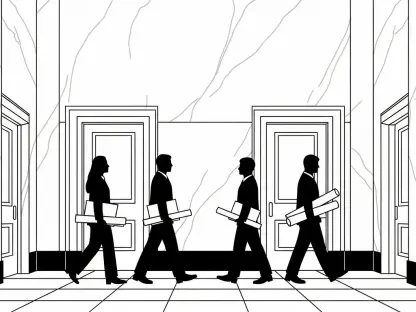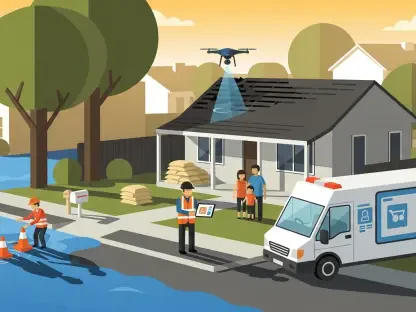As climate change intensifies, bringing more frequent and severe natural disasters like wildfires, hailstorms, and flooding, the insurance industry faces an unprecedented challenge in managing escalating risks, while the increasing cost of these events, often reaching billions of dollars in losses, exposes vulnerabilities in traditional risk assessment and underwriting practices. While technology, particularly artificial intelligence (AI), offers transformative potential to address these issues, questions linger about whether the sector is prepared to embrace such innovations at the scale and speed required. A recent survey of over 220 property and casualty executives reveals a troubling gap between awareness of climate-driven threats and the adoption of modern tools to combat them. This discrepancy raises critical concerns about the industry’s readiness to adapt to a rapidly changing risk landscape, highlighting the urgent need for a strategic shift toward data-driven solutions that can better predict and mitigate losses in an era of environmental uncertainty.
Navigating a Fragmented Response to Climate Volatility
The insurance sector’s response to climate change appears fragmented, with a significant portion of industry leaders expressing concern over the pace of adaptation. A staggering 61% of surveyed executives believe the industry as a whole is failing to keep up with the evolving risk profiles driven by environmental shifts. Although 64% feel their own companies are progressing faster than the broader market, this self-assessed optimism does not mask the systemic challenges that persist. The disparity between individual perceptions and collective progress suggests a lack of unified action, where firms may prioritize internal advancements over collaborative efforts to address widespread vulnerabilities. This uneven approach risks leaving the sector exposed to catastrophic losses, especially as climate-related events grow in both frequency and impact. Without a cohesive strategy, the industry struggles to build the resilience needed to protect policyholders and maintain financial stability in the face of mounting threats.
Furthermore, the reliance on outdated frameworks exacerbates the challenge of responding to climate volatility. Many insurers continue to depend on legacy actuarial models that were designed for a more stable risk environment, ill-suited to capture the nuanced, property-specific patterns of loss seen today. These traditional tools often fail to account for the clustering of damages caused by modern disasters, leading to inaccurate predictions and inadequate pricing. The survey indicates that while a majority of executives acknowledge these shortcomings, there remains a hesitancy to pivot away from familiar methods. This inertia not only undermines the ability to assess risks accurately but also delays the implementation of more effective solutions. As billion-dollar disasters become more common, the cost of inaction grows, pushing the industry toward a tipping point where adaptation is no longer optional but essential for survival in a changing world.
The Promise and Pitfalls of AI in Risk Management
Artificial intelligence holds immense promise for revolutionizing how insurers manage climate-related risks, yet its adoption remains inconsistent across the sector. A significant 68% of executives recognize that AI-driven models can outperform traditional methods in predicting and mitigating losses tied to natural disasters. Additionally, nearly three-quarters see AI as a pathway to new revenue streams and enhanced underwriting precision. Despite this enthusiasm, only 40% of carriers have integrated AI into their core operations, and a mere 25% rely on it as a primary tool for specific perils. This gap between recognition and implementation reveals barriers such as cost, lack of expertise, or cultural resistance to technological change. The slow uptake leaves many insurers unprepared for the accelerating pace of climate threats, highlighting a critical need to bridge the divide between potential and practice.
Equally concerning is the lack of adequate risk models for certain climate-driven perils, even as their impact intensifies. The survey found that 15% of insurers have no model for non-weather water damage, 14% for attritional fire, and 12% for wildfires and severe convective storms. This absence of tailored solutions creates dangerous blind spots, particularly as these events contribute to rising loss totals. While AI offers the ability to analyze vast datasets and provide granular, property-level insights, the industry’s hesitation to fully embrace it risks perpetuating these vulnerabilities. Leaders must prioritize investment in advanced technologies to close these gaps, ensuring that risk assessment keeps pace with the evolving nature of environmental hazards. Without such progress, the sector remains ill-equipped to handle the scale of challenges posed by a warming planet, jeopardizing both financial outcomes and customer trust.
Modernizing for a Resilient Future
Looking back, the insurance industry grappled with a pivotal moment where the urgency to modernize risk management became undeniable. The slow adoption of AI and the persistence of outdated models had left many carriers exposed to escalating climate-driven losses. While the potential of advanced technology to transform underwriting and claims processes was widely acknowledged, practical hurdles like cost and resistance to change had hindered widespread integration. The gaps in preparedness for specific perils underscored the high stakes of inaction, as billion-dollar disasters became a recurring reality. Reflecting on this period, it was clear that the sector had stood at a crossroads, balancing the comfort of traditional practices against the necessity of innovation. Moving forward, the focus shifted to actionable steps—investing in AI infrastructure, fostering industry-wide collaboration, and prioritizing data-driven strategies. These efforts aimed to build a more resilient framework, ensuring that insurers could not only predict risks with greater accuracy but also safeguard communities against the growing unpredictability of nature.









